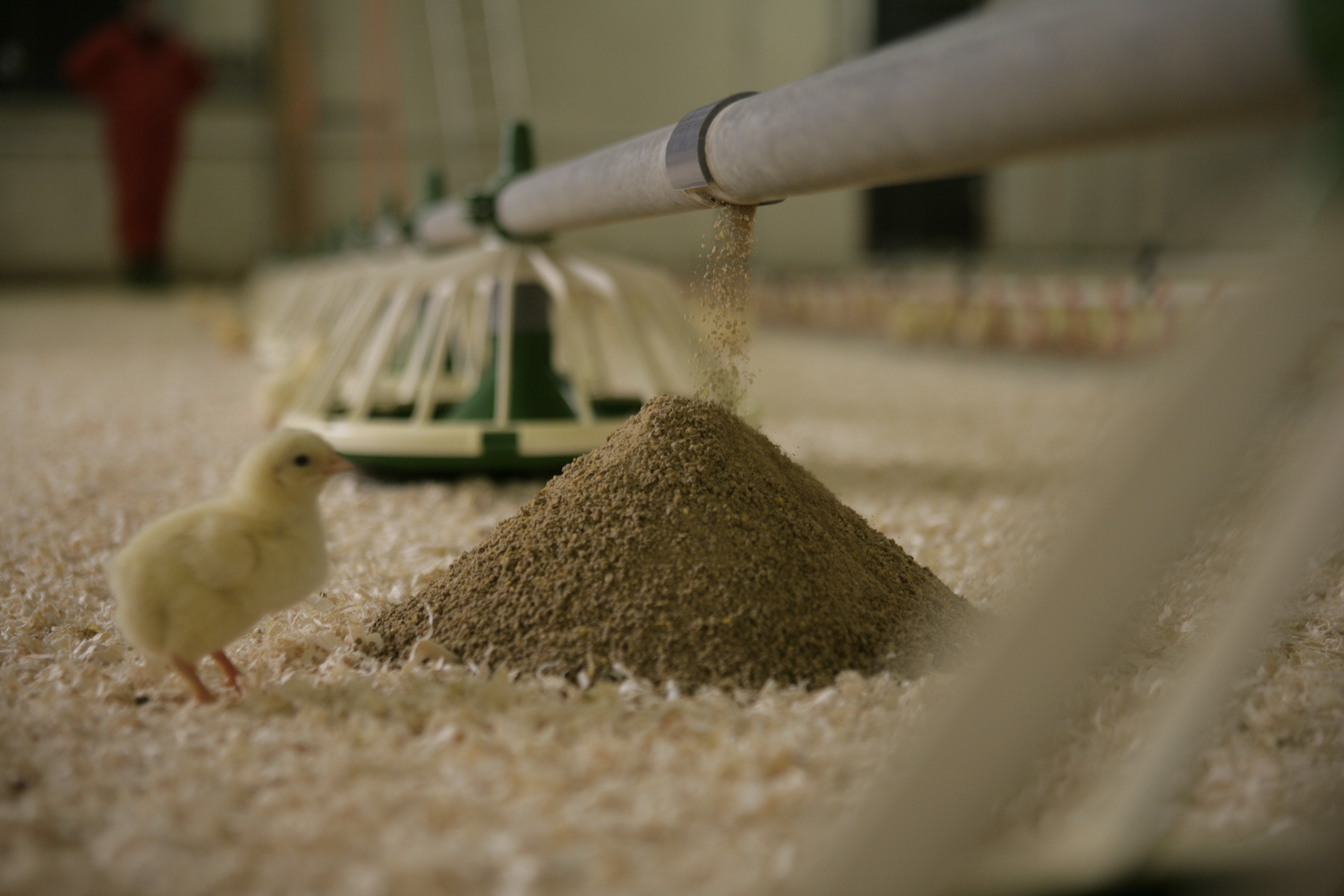A feed determined multi-enzyme approach

Current enzyme solutions are derived from widely varying microbial origins, each contributing a whole range of side activities. Considering that each fermentation activity releases several different enzymes, the end product is an extremely complex blend of enzymes.
Nowadays many raw materials from diverse origins are used in the formulation of animal feeds. Although most raw materials are principally included as an energy source, a source of amino acids or both, each raw material also introduces specific fibre fractions into the feed. Monogastric diets are consequently characterised by a complex fibre composition. The major part of the fibre fraction consists of non-starch polysaccharides (NSP). The NSP fractions of most feed raw materials have been identified very well. The NSP levels may vary significantly with crop variety and growth conditions.
Mixed-link beta-(1,3)-(1,4)-glucan is exclusively found in cereals. Arabinoxylan occurs generally in all raw materials, but mostly as water-unextractable (WU) arabinoxylan. However, in small grain cereals significant amounts of water-extractable (WE) arabinoxylan may also occur, which are responsible for increased viscosities in the gastrointestinal tract. Cellulose is also a common fibre component, being more abundant in vegetable materials than in cereals. Pectic substances include complex polysaccharides such as polygalacturonan, rhamnogalacturonam, arabinan and galactan, occurring exclusively in vegetable feed raw materials. All types of NSP mentioned so far are naturally part of the plant cell wall structure, and are referred to as structural NSP. Although the amount of soluble, structural NSP is limited, breaking them down is of primary importance to avoid viscosity problems. Partial degradation of the insoluble, structural NSP is required to release nutrients, which are encapsulated in the cell wall fibre network, more efficiently from the feed matrix.
Monogastric diets requires complex products
The above mentioned diet complexity, NSP diversity and variability clearly defines the choice of the correct enzyme solution, that enables to target the maximum amount of potentially degradable substrate. Therefore it is advisable to choose a complex blend on enzymes that translates its complexity into a wide functionality to ensure a wider range of action to improve nutritional value of the diets.
Kemin has developed Kemzyme Plus aimed at targeting all potentially degradable substrates of monogastric diets thus improving their nutritional value. The product contains three declared-quantified enzyme activities for the degradation of structural NSP: beta-glucanase, xylanase and cellulase. It also provides declared-quantified amylase and protease (present in the dry formula only) that enhance the action of the endogenous digestive enzyme which is especially important during early rearing. Each declared-quantified activity is produced from a selected microbial strain, having a high production yield of the specified enzyme and an excellent in vitro performance. Using products derived from separate microbial fermentations allows the flexibility to develop optimal, synergistic enzyme mixtures. Moreover, each fermentation product that is used as a raw material for the product is controlled separately to assure that the declared-quantified activity is consistently present from batch to batch. The complex formulation of enzymes translates into a wide functionality covering pH range, selectivity for different forms of a specific NSP fraction, a synergistic action of multiple enzymes and resistance against natural enzyme inhibitors.
Each microbial strain brings along several side activities
When a microorganism is cultured on a natural substrate, it produces a whole spectrum of enzymes which allow it to break down the substrate, to absorb it and grow. Although fermentation conditions are optimised to achieve the highest level of the main activity, many different enzymes are produced by a single microorganism. These non-declared enzymes are often referred to as side-activities. For blends of multiple fermentation products, this means that each component brings along its own range of side activities. Each component of the product contains its own range of side activities, so a multiple of 42 enzymes may be present. Therefore, this product is a complex mixture of enzymes originating from the fungi Aspergillus aculeatus, Trichoderma viride, Trichoderma reesei and the bacterium Bacillus amyloliquefaciens.
There is a major benefit from using multiple, molecular forms of specific enzymes, for instance different types of xylanase. This will increase the spectrum of activity against a specific substrate, which may vary subtly but continuously in nature. These benefits can be demonstrated in several aspects that are directly related to the performance of commercial enzyme products in animal nutrition (Figure 1).
Figure 1 – Performance benefits of a commercial multi-enzyme product*.

Wider pH range
Each enzyme has a characteristic optimal pH for activity. When two xylanases such as Xyn1 and Xyn2 from Trichoderma reseei are combined, each enzyme has its own optimal pH so the overall xylanase activity will have a much wider pH range than the range observed for the individual components. Considering that the pH conditions during feed digestion vary widely between pH 2 and pH 8, the action of multiple enzymes with different optimal pH is required. A product containing both fungal enzymes, generally having optimal activity in acidic conditions, and bacterial enzymes, typically active in neutral pH conditions, will match the pH conditions of the whole gastrointestinal tract.
Higher affinity for the substrate
Although several enzymes may attack the same substrate, relative differences in selectivity result in different in vivo features. The xylanase from Aspergillus aculeatus, present as a side activity, is only active on water-extractable arabinoxylan, which is an excellent feature when targeting viscosity reduction. However, breakdown of water-unextractable arabinoxylan is also required to release nutrients from the feed matrix. Xylanases from Trichoderma reseei are active both on the soluble and insoluble arabinoxylan. The product combines both xylanase sources to assure that both types of arabinoxylan are efficiently targeted.
Synergetic action
Carbohydrates in plant materials are very complex by nature. In most cases the coordinated action of several enzymes is required for degradation of the substance. Enzymes with different specificities work synergistically when acting together on the same substrate. A classic example is the cellulase complex from Trichoderma ressei: while cellulase alone is active only on amorphous cellulose, the combined structure of cellulase, exoglucanase and beta-glucosidase is also active on crystalline cellulose fibrils, which are the main structural cell wall component in plants.
Enzyme inhibitors
In almost all major feed raw materials, enzyme inhibitors have been identified, which may reduce the performance of exogenous enzymes to a major extent. The types and levels of inhibitors vary hugely with crop variety and culture conditions. However, the sensitivity of enzymes to these natural inhibitors is predominantly determined by the microbial origin of the enzyme. Xylanase inhibitors from wheat strongly inhibit xylanase from the Bacillus species, whereas the inhibition of Trichoderma xylanases is only partial and the xylanase from Aspergillus aculeatus is not inhibited at all. Therefore a multi-enzyme complex produced by multi-fermentation can cope with the natural variations of inhibitors in feed raw materials.











